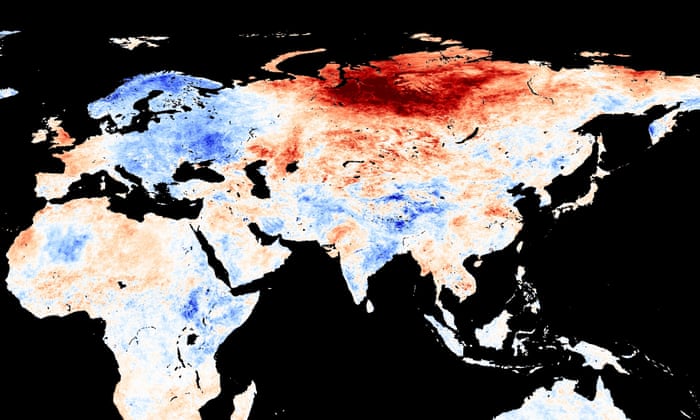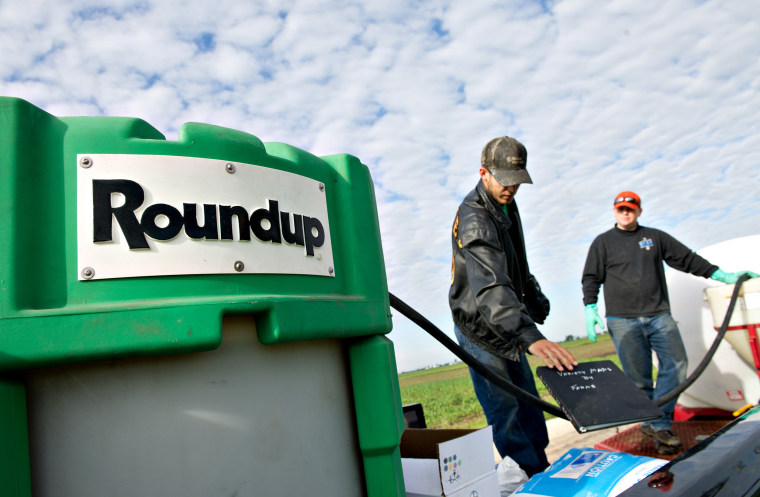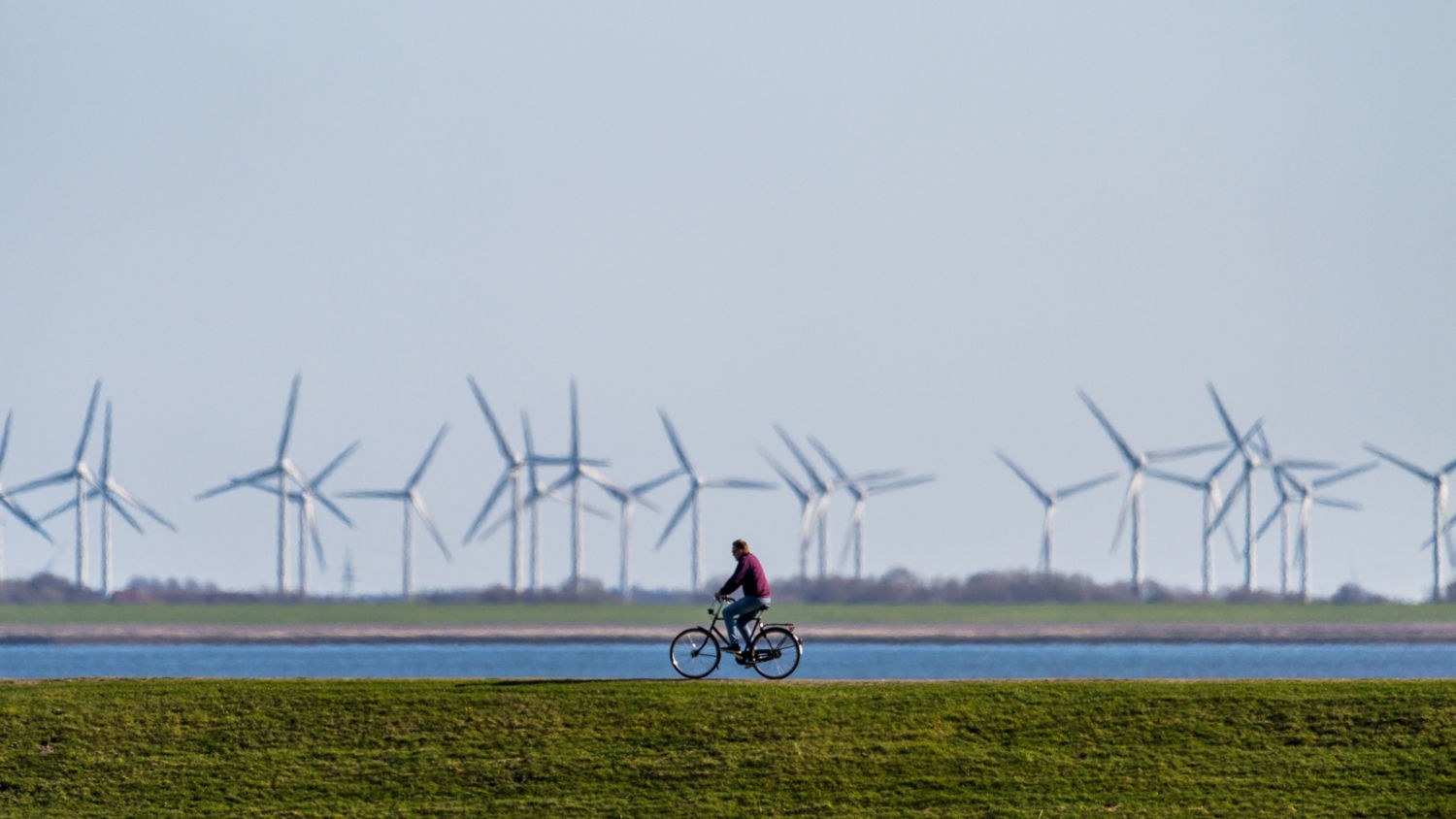July 7, 2020
I. Climate Change
Record Winter Heat Wave in Siberia
Story from The Guardian, Jun. 17, 2020.

Temperatures in the polar regions have been rising faster relative to other parts of the globe due to ocean currents carrying heat toward the poles. Russia, in general, experienced an extremely warm winter with record high temperatures. In Siberia, a Chief meteorologist affiliated with Russia’s weather service reported this was the hottest winter by 6 ºC (12.7 ºF) since records began 130 years ago. In Many parts of Siberia recorded temperatures were 10 ºC (21.2 ºF) above average. The extreme temperatures continued from winter to summer with the Siberian village of Verkhoyansk registering a record 100.4 ºF.
The warm winter with a lack of snow, the 24-hour days of sunlight in summer and the lack of white background to reflect sunlight created a warm air mass over Siberia. This uneven nature of weather forming an air mass over one area and hiking temperatures to record highs has a few specific notable affects:
- The permafrost in Siberia is defrosting and was partly to blame for a diesel fuel spill recently in that region
- Swarms of Siberian silk moths with larvae that feed on conifer tree needles making trees more susceptible to fires.
- Wildfires rage across Siberia.
II. Fossil Fuels
Story from Marketwatch, Jun 23, 2020.
 For the first time, a majority of Chevron shareholders’ proxy votes recognize climate change. On May 27, fifty-three percent of shareholders aligned themselves with most countries of the world to support the Paris Agreement. This is a landmark decision by a major American oil company, signaling an evolution within the petroleum energy sector. Since Chevron has spent much time and funds toward lobbying to prevent action on climate change, this could be a concession that will require transparency in how the company lobbies governments and takes the goals of the Paris Agreement seriously.
For the first time, a majority of Chevron shareholders’ proxy votes recognize climate change. On May 27, fifty-three percent of shareholders aligned themselves with most countries of the world to support the Paris Agreement. This is a landmark decision by a major American oil company, signaling an evolution within the petroleum energy sector. Since Chevron has spent much time and funds toward lobbying to prevent action on climate change, this could be a concession that will require transparency in how the company lobbies governments and takes the goals of the Paris Agreement seriously.
Chevron management has responded to the shareholder vote claiming that it already discloses extensive information about its lobbying efforts and political contributions. Another official statement said, “We value feedback from stockholders” and “will carefully consider the voting results”. Chevron, along with ExxonMobil, are accused of being laggards in the industry regarding carbon-cutting goals.
Europe’s largest oil companies are on board with an initiative put forth by Climate Action 100+, an investment signatory organization. Climate Action 100+, launched in 2017, is an organization with over 400 investor signatories. It has been lobbying companies to get on board with the Paris Agreement and made an impressive appearance at the UN’s COP 24 Conference on Climate Change in 2018. It consists of more than 450 leading asset managers, pension funds and other investments with a combined $40 trillion in assets.
Hundreds of companies spanning just about all sectors believe in a “science-based” business strategy that attempts to get world businesses in alignment with the Paris Agreement. They commit to:
- Implementing a strong governance framework with climate change oversight,
- taking action regarding greenhouse gas emissions, and
- providing disclosure around meeting the global climate change goals of the Paris Agreement.
III. Water, Food, Forests and Pesticide Reports
UPDATE: Bayer Settles Most Monsanto Lawsuits
Story from The New York Times, Jun. 24, 2020.
 The Bayer corporation acquired ownership of Monsanto Corp. in 2018, thereby inheriting thousands of lawsuits that were pending against Monsanto’s RoundUp herbicide containing glyphosate. Glyphosate is the active ingredient in RoundUp and is alleged to cause lymphoma, especially in workers handling the product.
The Bayer corporation acquired ownership of Monsanto Corp. in 2018, thereby inheriting thousands of lawsuits that were pending against Monsanto’s RoundUp herbicide containing glyphosate. Glyphosate is the active ingredient in RoundUp and is alleged to cause lymphoma, especially in workers handling the product.
Bayer is now moving forward with one of the largest settlements ever in the U.S. It calls for the company to pay out more than $10 billion for over 95,000 claims. Bayer is making available $8.8 billion to $9.6 billion and $1.25 billion for class-action cases not yet filed. The total number of cases, filed and unfiled, number around 125,000 and this would settle about 75% of those. About 30,000 cases chose not to be part of the settlement.
The company will set aside another $1.25 billion to establish a panel of expert researchers to determine the safety of glyphosate. If the expert panel concludes that it is not safe, Bayer loses its ability to argue the chemical’s safety in future trials. If it concludes that it is safe, the class action lawsuits will not be able to argue that glyphosate is unsafe. In the meantime, Bayer admits no wrong doing and is allowed to continue selling RoundUp without additional safety warnings.
Other cases resolved by Bayer include PCB waste water contamination from 1977 totaling $820 million and also up to $400 million to resolve lawsuits against the company for their weed-killer herbicide, dicamba. The product is notorious for drifting and causing damage to neighboring farmlands.
Plastics Blowing in the Wind
Story from Science, Jun 11, 2020.

New studies show that as much as 1,000 tons of plastic particles in the form of dust are showing up in remote wilderness areas and national parks, especially in the western states. In fact, microscopic plastic particles are becoming common worldwide.
Janice Brahney, a biochemist at Utah State University who was studying nutrients in dust, stumbled on the prevalence of plastic particles. She focused on 11 areas in the western U.S., including the Grand Canyon, and discovered that a large portion of microscopic dust particles were actually tiny pieces of plastic.
The particles consisted of tiny fibers found in textiles like those used in clothing and carpets. Other particles were of the round bead-type of plastic used in paints. These are smaller than the plastic beads found in cosmetics and other personal care products. The spheres accounted for 30% of her samples, while the other 70% consisted of the fiber-type of particle.
Ms Brahney concluded that about 75% of the smallest plastic particles are coming from distant locations, possibly from thousands of miles away, through high atmospheric dry winds and deposited as dry dust. Other amounts are carried in local rain storms. Further studies are forthcoming and are geared toward answering questions about the effects on animal and plant species.
IV. Politics
Europe Poised to Lead a Green Global Recovery
Stories from YaleEnvironment360, Jun 11, 2020; European Data Journalism Network, Jan 21, 2020.
 As the world moves toward an economic recovery from the COVID-19 pandemic, Europe is getting serious about their recently adopted Green New Deal legislation. They passed their Green New Deal before the COVID-19 hit the western hemisphere but, this year, in funding the initiative to the tune of $1.1 trillion, a stark reality of the moment was recognized and they seized the opportunity to move with this plan toward a newer, more practical direction. By doing this they certainly have the limelight as a leader on the global stage of dealing with the climate crisis.
As the world moves toward an economic recovery from the COVID-19 pandemic, Europe is getting serious about their recently adopted Green New Deal legislation. They passed their Green New Deal before the COVID-19 hit the western hemisphere but, this year, in funding the initiative to the tune of $1.1 trillion, a stark reality of the moment was recognized and they seized the opportunity to move with this plan toward a newer, more practical direction. By doing this they certainly have the limelight as a leader on the global stage of dealing with the climate crisis.
The United States is moving along a path with relaxed pollution controls in the form of stimulus packages that ignore climate change, and a plan to return to an economy that’s geared to burn as much fossil fuel as possible. Unless the U.S. makes drastic changes, Europe’s plan will not resemble the recovery stimulus of the U.S. It will be a concerted effort to reframe their economics into an initiative that will lead Europe toward de-carbonizing while simultaneously achieving a “just transition” for its workers. Instead of just letting workers go after achieving goals toward renewable energy, the European plan takes their workers to heart. There will be many changes coming that leave many work force jobs at risk, however by working collaboratively with industries that have bought into the transition, training and new jobs will be central to the plan.
The European continent has traditionally been heavily dependent on coal and recognizes the struggle to transition to greener sources of energy. Germany and Poland are still dependent on coal, accounting for half of all of Europe’s coal consumption. Germany gets 40% of its energy from coal but has a concerted effort toward declining those generators with a coal termination date of 2038. Poland and other European countries, also, still have a lot of work to do in this regard. The UK is steering away from coal and France has steadily maintained a generally low consumption of coal for energy. The markets in Europe are already geared toward building renewable energy. Even European oil companies, Equinor, Shell, and Total, are seeking new technologies by seriously building carbon capture and sequestration into their models. Others, BP and Engie, are looking at hydrogen fuel networks.
V. Miscellaneous Items
Tree Networks in a Forest
Story from EcoWatch, Jun. 19, 2020. YaleEnvironment360, Sep. 1, 2016; YouTube, Aug. 30, 2016.
 Suzanne Simard, a forestry ecologist, made an amazing observation while researching her doctoral thesis in a Canadian forest. She has shown what other scientists have been working on, that trees in a forest actually communicate with each other, at least in a nutrient sort of way. The trees do this through a network of root systems that involves a latticework of fungi in the soil. Using carbon isotope tracers, she was able to see how one tree sends a message to another and vice versa. The trees were actually transferring nutrients from one to the other. By extending this over measured sections in a forest it became clear that trees have connections to share information and nutrients, thereby maintaining a forest network. It appears that trees even show favoritism to their own offspring!
Suzanne Simard, a forestry ecologist, made an amazing observation while researching her doctoral thesis in a Canadian forest. She has shown what other scientists have been working on, that trees in a forest actually communicate with each other, at least in a nutrient sort of way. The trees do this through a network of root systems that involves a latticework of fungi in the soil. Using carbon isotope tracers, she was able to see how one tree sends a message to another and vice versa. The trees were actually transferring nutrients from one to the other. By extending this over measured sections in a forest it became clear that trees have connections to share information and nutrients, thereby maintaining a forest network. It appears that trees even show favoritism to their own offspring!
Ms Simard found that this network takes place with symbiotic relationships between the trees and a soil fungi called ectomychorrhiza (genus Rhizopogon) that inhabits coniferous fir forests. The fungi send out hair-like roots that intertwine with tree roots and share a network that has been nicknamed the “Wood Wide Web”. By linking with tree roots it completes a circuit of transporting nutrients to neighboring trees.
The fungi send out a lattice system called mycelium, which is a mass of threads. These threads pick up nutrients in the soil and bring them to the tree roots. These mycelium-based exchanges of phosphorous, nitrogen, water and other nutrients are provided to nearby trees. This subsurface network connects root systems of one tree to another and can even deny nutrients to dangerous or invasive species.
Suzanne Simard has done work with fir trees networking with birch trees. Her work also delves into insect infestations in forests, forest resilience, clear cutting and the effects of climate change. Here’s a YouTube video of her TED Talk in 2016.
VI. Events
Monday, Jul 6, 6:00am – 7:00pm, 350 Bay Area Climate Chat
- Biweekly climate chat – this week: fossil fuel resistance.
- RSVP to link above.
Monday, Jul 6, 7:00 – 8:00 pm, Plastic and the Pandemic Fireside Chat
- Presentation on what is happening witn plastic during pandemic
- Send email to: EastBay.Bungalows@gmail.com.
Wednesdays, Jul 8, 15 & 22, 12:30 – 1:30 pm, Eco Lunch Bunch – Plastics discussions
- Different topics around plastics each week – online
- Connect with link above.
Fridays, Jul 10, 17 & 24, 11:00 – 1:00 pm, Adult “Trashion” Fashion Workshop Series
- A virtual fashion workshop using recyclables, fee.
- Connect with link above.
Fridays, Jul 10, 17 & 24, 12:00 – 1:00 pm, “In the Know” with Olga Bolotina
- An online interview with Sierra Club members
- RSVP with link above or with Sierra Club Calendar.
Saturdays, Jul 11, 18, 27, 10:00 – 11:00 am, Songbirds, Seabirds, and More
- An online webinar
- Connect with link above.
Saturday, Jul 18 , 10:30am – 12:30pm, 350 Bay Area Monthly Meeting
- Zoom meeting with orientation for newcomers at 10:00am
- Connect with link above.
Saturday, Jul 18, 12:00 – 3:00 pm, Beer, Dunes, & Trains
- Walking tour of SOMA district with emphasis on the past, fee requested.
- Meet at SOMARTS, 934 Brannan St., SF.
Saturdays, Jul 23 – 24, 12:30 – 4:30pm, Virtual 10th Chinook Run Symposium
- An online webinar, two half-day workshops, fee
- Register with link above.
Thursday, Jul 30, 6:00 – 7:30 pm, The Story of Plastics Virtual Watch Party
- Speakers with discussion on plastics – Ecology Center event.
- Connect with link above.
Other Sources of Events:
Friends of the Earth – located at the David Brower Center, Berkeley.
350Bay Area – Includes other 350.org branches in the Bay Area.
Planet Drum – San Francisco bioregion awareness center.
Ecology Center – Berkeley sustainability center.
David Brower Center – The environmental center in Berkeley.
Sunflower Alliance – Bay Area umbrella organization for activism.
Sierra Club San Francisco – Bay Area website.

The End